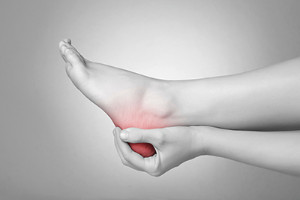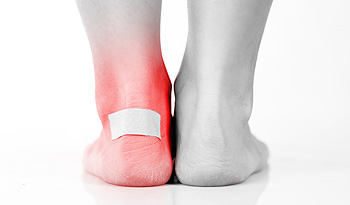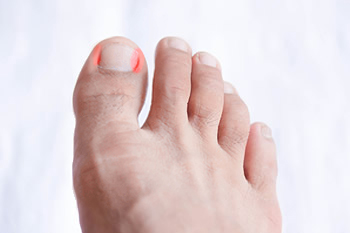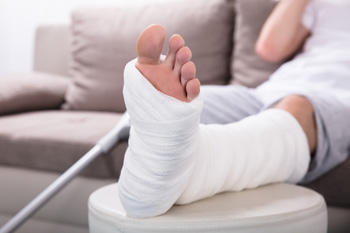 The location of the band of tissue that is referred to as the plantar fascia is found on the sole of the foot. It connects the heel bone to the toes, and provides support for the arch. An injury or gradual overuse can cause a condition that is known as plantar fasciitis, and can cause difficulty in walking. Tight calf muscles or flat feet can contribute to the onset of plantar fasciitis. Some of the symptoms that are associated with this condition can consist of pain and discomfort in the morning after arising, and it can last throughout the day. Additionally, the pain may increase if the shoes that are worn do not have adequate support. This ailment can be common among people who enjoy running, and it is beneficial to refrain from participating in similar activities until the healing process is completed. If you have pain in your heel or arch, it is strongly suggested that you consult with a podiatrist as quickly as possible so they can determine what the best course of treatment is for you.
The location of the band of tissue that is referred to as the plantar fascia is found on the sole of the foot. It connects the heel bone to the toes, and provides support for the arch. An injury or gradual overuse can cause a condition that is known as plantar fasciitis, and can cause difficulty in walking. Tight calf muscles or flat feet can contribute to the onset of plantar fasciitis. Some of the symptoms that are associated with this condition can consist of pain and discomfort in the morning after arising, and it can last throughout the day. Additionally, the pain may increase if the shoes that are worn do not have adequate support. This ailment can be common among people who enjoy running, and it is beneficial to refrain from participating in similar activities until the healing process is completed. If you have pain in your heel or arch, it is strongly suggested that you consult with a podiatrist as quickly as possible so they can determine what the best course of treatment is for you.
Plantar fasciitis is a common foot condition that is often caused by a strain injury. If you are experiencing heel pain or symptoms of plantar fasciitis, contact Dr. Richard DiMario from Maine. Our doctor can provide the care you need to keep you pain-free and on your feet.
What Is Plantar Fasciitis?
Plantar fasciitis is one of the most common causes of heel pain. The plantar fascia is a ligament that connects your heel to the front of your foot. When this ligament becomes inflamed, plantar fasciitis is the result. If you have plantar fasciitis you will have a stabbing pain that usually occurs with your first steps in the morning. As the day progresses and you walk around more, this pain will start to disappear, but it will return after long periods of standing or sitting.
What Causes Plantar Fasciitis?
There are some risk factors that may make you more likely to develop plantar fasciitis compared to others. The condition most commonly affects adults between the ages of 40 and 60. It also tends to affect people who are obese because the extra pounds result in extra stress being placed on the plantar fascia.
Prevention
There are a variety of treatment options available for plantar fasciitis along with the pain that accompanies it. Additionally, physical therapy is a very important component in the treatment process. It is important that you meet with your podiatrist to determine which treatment option is best for you.
If you have any questions, please feel free to contact our office located in York, ME . We offer the newest diagnostic and treatment technologies for all your foot care needs.
The cuboid bone is one of seven tarsal bones in the foot. It is located on the outside of the foot, midway between the heel and the pinky toe. Cuboid syndrome occurs when this bone becomes dislocated from overuse or from an injury such as a sprained ankle. It may also be caused by foot conditions such as pronated feet. Cuboid syndrome often affects dancers, athletes, and runners. Pain can be felt in various parts of the foot—often in the middle of the foot or at the base of the two smaller toes, or elsewhere in the foot or ankle. Other symptoms may include difficulty walking, swelling, and reduced range of motion in the ankle and foot. Because it can be difficult to pinpoint exactly where the pain is emanating from, it is important to have your foot examined and properly diagnosed by a podiatrist if you are experiencing any of the symptoms in order to recieve proper treatment.
Cuboid syndrome, also known as cuboid subluxation, occurs when the joints and ligaments near the cuboid bone in the foot become torn. If you have cuboid syndrome, consult with Dr. Richard DiMario from Maine. Our doctor will assess your condition and provide you with quality foot and ankle treatment.
Cuboid syndrome is a common cause of lateral foot pain, which is pain on the outside of the foot. The condition may happen suddenly due to an ankle sprain, or it may develop slowly overtime from repetitive tension through the bone and surrounding structures.
Causes
The most common causes of cuboid syndrome include:
Symptoms
A common symptom of cuboid syndrome is pain along the outside of the foot which can be felt in the ankle and toes. This pain may create walking difficulties and may cause those with the condition to walk with a limp.
Diagnosis
Diagnosis of cuboid syndrome is often difficult, and it is often misdiagnosed. X-rays, MRIs and CT scans often fail to properly show the cuboid subluxation. Although there isn’t a specific test used to diagnose cuboid syndrome, your podiatrist will usually check if pain is felt while pressing firmly on the cuboid bone of your foot.
Treatment
Just as the range of causes varies widely, so do treatments. Some more common treatments are ice therapy, rest, exercise, taping, and orthotics.
If you have any questions, please feel free to contact our office located in York, ME . We offer the newest diagnostic and treatment technologies for all your foot care needs.
 Blisters are fluid-filled bubbles that form between the top-most layer of skin and the layer beneath it. Blisters typically develop on the feet as a protective measure for your skin in response to friction. They often heal best when they are left alone, but some blisters can be quite painful or pop due to friction. You can help the blister heal by covering it loosely with a bandage or blister pad. Don’t touch or pop the blister, as this can expose the raw skin underneath it to germs and increase the risk of infection. If your blister continues to be very painful, does not seem to be healing well on its own, is showing signs of infection, or if you have diabetes, it is suggested that you seek the care of a podiatrist.
Blisters are fluid-filled bubbles that form between the top-most layer of skin and the layer beneath it. Blisters typically develop on the feet as a protective measure for your skin in response to friction. They often heal best when they are left alone, but some blisters can be quite painful or pop due to friction. You can help the blister heal by covering it loosely with a bandage or blister pad. Don’t touch or pop the blister, as this can expose the raw skin underneath it to germs and increase the risk of infection. If your blister continues to be very painful, does not seem to be healing well on its own, is showing signs of infection, or if you have diabetes, it is suggested that you seek the care of a podiatrist.
Blisters may appear as a single bubble or in a cluster. They can cause a lot of pain and may be filled with pus, blood, or watery serum. If your feet are hurting, contact Dr. Richard DiMario of Maine. Our doctor can provide the care you need to keep you pain-free and on your feet.
Foot Blisters
Foot blisters are often the result of friction. This happens due to the constant rubbing from shoes, which can lead to pain.
What Are Foot Blisters?
A foot blister is a small fluid-filled pocket that forms on the upper-most layer of the skin. Blisters are filled with clear fluid and can lead to blood drainage or pus if the area becomes infected.
Symptoms
(Blister symptoms may vary depending on what is causing them)
Prevention & Treatment
In order to prevent blisters, you should be sure to wear comfortable shoes with socks that cushion your feet and absorb sweat. Breaking a blister open may increase your chances of developing an infection. However, if your blister breaks, you should wash the area with soap and water immediately and then apply a bandage to the affected area. If your blisters cause severe pain it is important that you call your podiatrist right away.
If you have any questions, please feel free to contact our office located in York, ME . We offer the newest diagnostic and treatment technologies for all your foot care needs.
 An ingrown toenail is defined as a nail that grows into the outside edges of the skin. It generally affects the big toe and can cause severe pain and discomfort. It can occur as a result of wearing shoes that do not have adequate room for the toes to move freely in, or possibly from genetic factors. Additionally, the shape of the nail may be conducive to developing an ingrown toenail. Research has indicated that ingrown toenails may happen more often in children and pregnant women. This can be a result of the accelerated speed of the nail growth. Mild relief may be found when the affected toe is soaked in warm water which can be beneficial in pulling the nail away from the softened skin. An ingrown toenail can easily become infected if not promptly treated. If you are afflicted with this ailment it is strongly suggested that you speak with a podiatrist who can properly treat this condition.
An ingrown toenail is defined as a nail that grows into the outside edges of the skin. It generally affects the big toe and can cause severe pain and discomfort. It can occur as a result of wearing shoes that do not have adequate room for the toes to move freely in, or possibly from genetic factors. Additionally, the shape of the nail may be conducive to developing an ingrown toenail. Research has indicated that ingrown toenails may happen more often in children and pregnant women. This can be a result of the accelerated speed of the nail growth. Mild relief may be found when the affected toe is soaked in warm water which can be beneficial in pulling the nail away from the softened skin. An ingrown toenail can easily become infected if not promptly treated. If you are afflicted with this ailment it is strongly suggested that you speak with a podiatrist who can properly treat this condition.
Ingrown toenails may initially present themselves as a minor discomfort, but they may progress into an infection in the skin without proper treatment. For more information about ingrown toenails, contact Dr. Richard DiMario of Maine. Our doctor can provide the care you need to keep you pain-free and on your feet.
Ingrown Toenails
Ingrown toenails are caused when the corner or side of a toenail grows into the soft flesh surrounding it. They often result in redness, swelling, pain, and in some cases, infection. This condition typically affects the big toe and may recur if it is not treated properly.
Causes
You are more likely to develop an ingrown toenail if you are obese, have diabetes, arthritis, or have any fungal infection in your nails. Additionally, people who have foot or toe deformities are at a higher risk of developing an ingrown toenail.
Symptoms
Some symptoms of ingrown toenails are redness, swelling, and pain. In rare cases, there may be a yellowish drainage coming from the nail.
Treatment
Ignoring an ingrown toenail can have serious complications. Infections of the nail border can progress to a deeper soft-tissue infection, which can then turn into a bone infection. You should always speak with your podiatrist if you suspect you have an ingrown toenail, especially if you have diabetes or poor circulation.
If you have any questions, please feel free to contact our office located in York, ME . We offer the newest diagnostic and treatment technologies for all your foot care needs.
 A fractured foot and a sprained foot can be difficult to tell apart as both conditions share several symptoms. A broken foot is typically more painful than a sprained foot, and the pain tends to last longer. Bruising, swelling, and tenderness are associated with both fractures and sprains, but are usually more severe in fractures. At the time of injury, you may hear a crack if there is a fracture, but a popping sound may occur if there is a sprain. Both fractures and sprains are likely to cause difficulty walking or bearing weight on the affected foot. If you have injured your foot, a podiatrist can use a combination of physical examination and imaging studies like X-rays, to determine the type of injury you have endured and which course of treatment is best for you.
A fractured foot and a sprained foot can be difficult to tell apart as both conditions share several symptoms. A broken foot is typically more painful than a sprained foot, and the pain tends to last longer. Bruising, swelling, and tenderness are associated with both fractures and sprains, but are usually more severe in fractures. At the time of injury, you may hear a crack if there is a fracture, but a popping sound may occur if there is a sprain. Both fractures and sprains are likely to cause difficulty walking or bearing weight on the affected foot. If you have injured your foot, a podiatrist can use a combination of physical examination and imaging studies like X-rays, to determine the type of injury you have endured and which course of treatment is best for you.
A broken foot requires immediate medical attention and treatment. If you need your feet checked, contact Dr. Richard DiMario from Maine. Our doctor can provide the care you need to keep you pain-free and on your feet.
Broken Foot Causes, Symptoms, and Treatment
A broken foot is caused by one of the bones in the foot typically breaking when bended, crushed, or stretched beyond its natural capabilities. Usually the location of the fracture indicates how the break occurred, whether it was through an object, fall, or any other type of injury.
Common Symptoms of Broken Feet:
Those that suspect they have a broken foot shoot seek urgent medical attention where a medical professional could diagnose the severity.
Treatment for broken bones varies depending on the cause, severity and location. Some will require the use of splints, casts or crutches while others could even involve surgery to repair the broken bones. Personal care includes the use of ice and keeping the foot stabilized and elevated.
If you have any questions please feel free to contact our office located in York, ME . We offer the newest diagnostic and treatment technologies for all your foot and ankle needs.